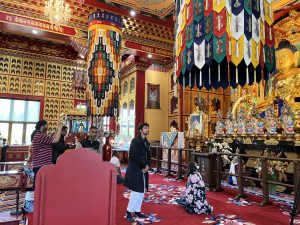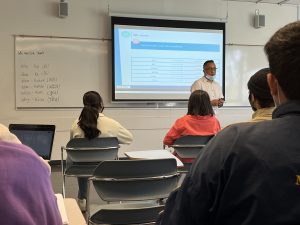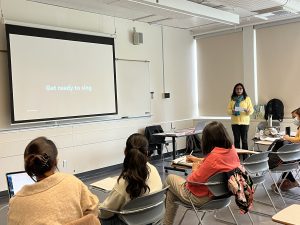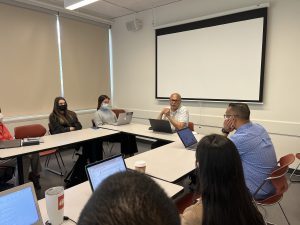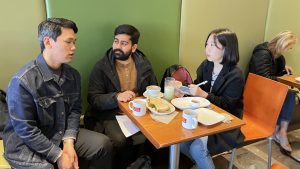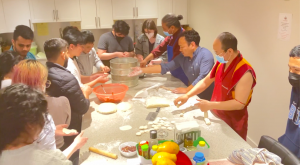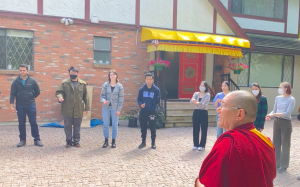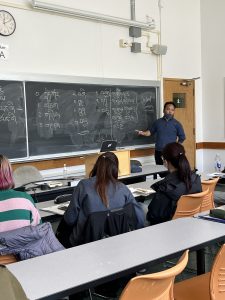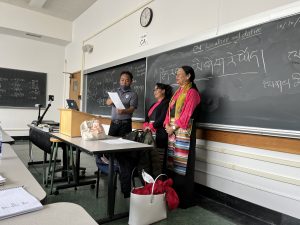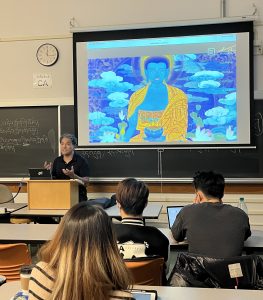2022 marked the seventh summer of our intensive, community-engaged Nepali and Tibetan courses, and the first time we returned back to in-person classes since 2019. Take a look below to see what happened!
To read about the Nepali language course (NEPL 390), click here |
|
|
To read about the Tibetan language course (TIBT 390), click here |
Program Overview
The UBC Himalaya Program has offered community-engaged Nepali and Tibetan language courses since 2016. They have grown from 1-week, 1-credit courses to 2-week, 3-credit courses for the fifth year in a row as of the summer of 2022. Due to the COVID-19 pandemic, this year marked the first summer since 2019 that classes returned back to in-person delivery. This year’s courses ran daily from Monday to Friday between May 16th – May 27th, 2022.
In addition to classroom instruction with professors Mr. Binod Shrestha (Nepali) and Mr. Sonam Chusang (Tibetan), students practiced language skills and gained intercultural experiences through community engagement activities. Students learned from and interacted with members of the British Columbian Tibetan and Nepali communities, such as artists, singers, and community leaders.

NEPALI 2022
Taught by Mr. Binod Shrestha.
Off-Campus Visits
The Nepali language class took two field trips off-campus to different Nepali community sites in the Lower Mainland.
On May 20th, the class visited Thrangu Monastery in Richmond. There, they met Sangpo Lama who gave them a tour of the monastery and answered students’ questions about his training and life as a Buddhist monk. Students were then split into three groups, and each group was paired with a monk to practice their Nepali conversation. The monastery provided a vegetarian lunch for the students before they finished off the day with a grammar lesson.
“It was challenging to be in a setting [like Thrangu Monastery] where people were speaking at a much faster pace than in class. However, it was a wonderful experience and I am grateful to the community members for taking time to welcome us.”
For the last day of class, the class visited the Hindu Buddhist Foundation of Canada in Surrey. The students were paired off with Nepali community members and got to know them by using the Nepali language skills they had gained in the two-week course. The activities were followed by a dinner catered by Spice of Nepal, and the students performed a sing-along of the song they had learned with Sabita Shrestha.
“It was nice to enjoy the food and relax with the class, who have become my friends now.”
“The most rewarding part of the day was being able to have a conversation with a fluent Nepali speaker, and to be told they can actually understand you very well!”
Class Experience
This year, Mr. Binod Shrestha adopted online learning activities from the past two years of remote learning into the in-person classroom, including Kahoot quizzes to reinforce students’ knowledge of new grammar and vocabulary. The students also participated in “speed dating,” an activity designed for the students to get to know one another, while learning to introduce themselves and ask questions in Nepali. The course covered lots of ground on Nepali grammar, script, pronunciation, and vocabulary.
“ I like how this course requires active in-person participation and how it also requires us to talk with our peers and converse with them in Nepali to improve our oral skills.”
“ Although it felt that learning a new language would be difficult in such a short amount of time, it was really nice to see how Binod is making everyone comfortable and excited about his culture and language.”
Class Visits
Nepali community member Sabita Shrestha returned to the class again this year to teach the students a Nepali song. This year, the class learned how to sing “Pareli Maa,” which they performed on the last day of class for many Nepali community members at the Hindu Buddhist Foundation of Canada (HBFC).
“Sabita was wonderful and she patiently went through the song many times so I felt comfortable with singing out loud with the class.”
UBC faculty members and Himalaya Program Steering Committee co-leads also joined the class to provide a guest lecture on the readings that the students were assigned. Professor Mark Turin, linguist and anthropologist, visited the class on May 19th in response to his article “Learning Nepali the SOAS Way.” He spoke about his experience learning Nepali as an English teacher in Nepal, and answered students’ questions about his article.
On May 25th, Professsor Ratna Shrestha joined a class to speak about an article he co-authored with Professors Sara Shneiderman and Ramjee Parajulee that explored dynamics of the Nepali diaspora in BC. He also showed the class pictures of his hometown in Nepal, which the class very much enjoyed.
“It feels like a family now where we know almost everything about our classmates and get to bond over the things that we are all very passionate about.”
“It [the class] is extremely fast-paced and yet, there is so much to be covered in such a short time, that it is also extremely exciting and satisfying to be challenged and to have to listen to the nuances of this new language.”
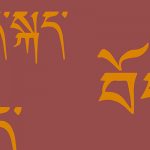 TIBETAN 2022
TIBETAN 2022
Taught by Mr. Sonam Chusang.
Off-Campus Visits
The Tibetan class took two field trips off-campus. These field trips allow the students to practice their new Tibetan language skills, and also gain an understanding of Tibetan spaces and experiences in Vancouver.
On May 20th, they visited Terra Breads on West 4th Ave., where many Tibetan community members are employed. As part of the field trip’s activities, the students practiced ordering their food in Tibetan. Students were then placed in small groups with Tibetan community members to practice Tibetan in conversation, and to learn more about the local Tibetan community.
|
|
To wrap-up the course, the class visited Tsengdok Monastery on May 27th for a full day of activities. The students were given a tour of the monastery, and then listened to Tsengdok Rinpoche speak about concepts in Buddhism including the importance of extending compassion towards others. Dr. Pema Yangchen, former Education Minister in the Tibetan Government-In-Exile, also spoke to the class briefly about her experience as a teacher and as the Education Minister. The students also participated in an incense ceremony led by the monks. The day ended with the students learning how to prepare momos (Tibetan dumplings) and an early dinner where the students performed “Dolma Lhakhang,” the song they learned with Lhaksam Metok.
|
|
Class Experience
As the course transitioned back into an in-person format, Mr. Sonam Chusang created many activities including partnered and small-group assignments that allowed students to familiarize themselves with both the Tibetan language and their peers. The Tibetan course led students through the script and pronunciation of the sound system as well as grammar and basic vocabulary.
“We learned about yes/no questions today and went around class asking and answering them. Activities like this are really helpful to keep me speaking and drilling in the sentence format.”
“I liked how instructor Sonam asked us to say simple phrases like ‘thank you’ and ‘teacher’ regularly throughout class so that we can get used to them.”
Classroom Visits
Different Tibetan and Tibetan-speaking community members joined the class throughout the course, which gave the students a chance to learn about different aspects of Tibetan culture from Tibetan community members themselves.
Acha Tsering and Acha Sangmo from the local Tibetan song-and-dance group Lhaksam Metok visited the class on May 24th. They taught the class how to sing the Tibetan song “Dolma Lhakhang (བོད་གཞས་སྒྲོལ་མ་ལྷ་ཁང་།)” in preparation for the class’ performance of the song at Tsengdok Monastery on the last day of the course.
|
Thangka artist Kalsang Dawa returned this year on May 26th to speak with the class about the training, process, and inspiration behind his paintings and its connections to Buddhism.
|
On May 25th, UBC Professor Tsering Shakya gave a guest lecture on an article he wrote about Tibetans in North America, as well as provide an overview of Tibetan history and politics. The students were asked to read the article before hand and write a reflection. Professor Shakya introduced the class to new Tibetan keywords such as “refugee” and “first,” and ended the lecture by answering students’ questions.
|
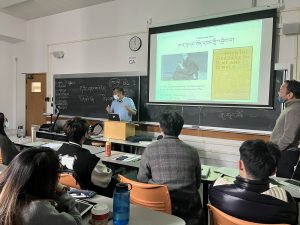
Professor Tsering Shakya (left) giving a guest lecture on the Tibetan diaspora in North America.
|
|
To receive up-to-date information about our courses and programs, please sign up for our mailing list.
These courses are supported by the Department of Asian Studies, UBC Faculty of Arts, the Teaching and Learning Enhancement Fund (TLEF), the Centre for Community Engaged Learning (CCEL), the School of Public Policy & Global Affairs / Institute of Asian Research, and UBC Go Global.
